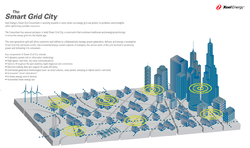Difference between revisions of "Smart Grid"
| Line 1: | Line 1: | ||
==Description== | ==Description== | ||
[[Image:smart1.png|thumb|Image of Smart City in Colorado. (excelenergy 2009)|right|250px]] | |||
[[Image:smart2.png|thumb|Image of Smart House in Colorado. (excelenergy 2009)|right|250px]] | |||
===What is a smart grid?=== | ===What is a smart grid?=== | ||
Latest revision as of 21:04, 14 October 2009
Description
What is a smart grid?
A smart grid delivers electricity from suppliers to consumers using digital technology to save energy, reduce cost and increase reliability and transparency. Such a modernized electricity network is being promoted by many governments as a way of addressing energy independence, global warming and emergency resilience issues.
What can a smart grid do?
Right now, if there's a breakdown at your local substation, the utility usually finds out when customers call to complain. Placing a networked sensor inside a transformer or along wires could locate and report a problem, or prevent it from happening in the first place. Despite living in the age of information, most of us only get a glimpse of our energy consumption when the utility bills come once a month. In people's homes, the smart grid should mean more detailed information through home energy-monitoring tools. These can be small displays or Web-based programs that give a real-time view of how much energy you're using, which appliances consume the most, and how your home compares to others. Just surfacing that information will give people ideas on how to shave energy bills by 5 to 15 percent, utility executives say. What's needed to start is a smart meter with two-way communications or some other kind of gateway. Once that conduit is put in place, consumers can get more detailed energy data and start taking advantage of efficiency incentives, such as charging your plug-in electric vehicle in the middle of the night to get off-peak rates. In theory, networked appliances are smarter and more efficient. GE and start-up display-maker Tendril, for example, will test big appliances--refrigerators, washing machines, and the like--that can get information on fluctuating electricity prices to do its job more efficiently. It could be as simple as making ice or running the dishwasher in the middle of the night. Or, as part of a home-area network, consumers could program lighting and major appliances on a schedule. The next step toward efficiency is what's called demand response. The goal here is to dial back energy consumption at peak times. This is very important to utilities because it's costly and polluting to bring on auxiliary power plants to meet, say, a spike in demand from the air conditioning load on a hot summer day. Consumers and businesses have financial incentives to participate, such as a discounted rate. "Shedding load" could mean turning the gas heat off of the clothes drier for a few minutes or dimming the lights in a supermarket in the middle of the day. A smarter grid also makes distributed energy, such as home solar systems, more viable and user-friendly. With a smart meter and monitoring software, a homeowner can see how much solar panels are producing and their carbon footprint is being reduced. A utility, too, is keenly interested in how much distributed energy is available so it can calibrate its own daily power generation.
Examlple:SmartGridCity in Boulder, Colorado
SmartGridCity is the nation's first fully integrated smart grid community and will boast the largest and densest concentration of these emerging technologies to date. Boulder, Colorado has been selected as the site of SmartGridCity.
Boulder is the right-sized city for a project such as this, and offers an ideal mix of residential and commercial customers. It's home to academic and research institutions (including Colorado University, National Center for Atmospheric Research, and the National Institute for Standards and Technology) already working with this emerging technology and studying long-term benefits. The Benefits of SmartGridCity
Over the next several years, SmartGridCity will offer the potential for:
- Adding more clean and green power sources in our fuel mix—greatly improving power delivery and reliability while optimizing environmental benefits.
- A grid that allows more choice about when, how much and what kind of energy you use.
- A digitally enhanced, more resilient and stable energy grid that is less prone to outages and improves power reliability.
- More energy efficiency and conservation options to manage your energy dollars.
SmartGridCity is a Forward-looking Investment
The current electricity grid hasn't changed much in the past 100 years, and it cannot keep up with growing demands. Today, customers' needs are growing faster than the current grid can handle. If we don't expand our capacity to keep up with a projected increase in demand of 40 percent over the next 25 years, we're going to see healthy grids become increasingly less reliable. This project also allows us to make our vision of a clean energy future a reality. The smart grid will take our energy system into the digital age and ensure that it continues to serve us well into the next century. Xcel Energy along with other consortium members Accenture, Current Group, Schweitzer Engineering Laboratories, Ventyx, GridPoint, OSI Soft as well as a other public and private.
Enabler
- Climate crisis
- Ambitious reduction targets of major emitters
- Deterioration of utility
- Strong political leadership
- Eco-friendly mindset
Inhibitor
- Disruption in COP15
- Oil price drop
- Economic crisis
Paradigms
- Digitalize life style information (new personal information)
- Energy would be de-centralized
- Accelerate the prevalence of renewable energy
- Energy would be another major investment tool
- People would become more conscious about environment
Experts
- GE
- Cisco
- IBM
- Accenture
Resources
- http://smartgridcity.xcelenergy.com/learn/downloads.asp
- http://www.nema.org/gov/energy/smartgrid/
- http://startuptrek.net/smart-grid-top-level-architecture/
- http://en.wikipedia.org/wiki/Smart_grid
- http://www.nytimes.com/imagepages/2008/04/20/magazine/20invent-graphic.ready.html
- http://www.oe.energy.gov/smartgrid.htm
- http://www.nytimes.com/imagepages/2008/04/20/magazine/20invent-graphic.ready.html
- http://news.cnet.com/8301-11128_3-10283295-54.html

